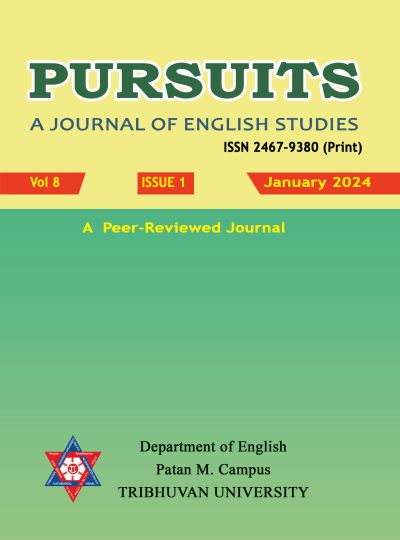Cross-Cultural Influences in The Satanic Verses
DOI:
https://doi.org/10.3126/pursuits.v8i1.65340Keywords:
Hybridity, Postcolonialism, Identity, DisaporaAbstract
The novel The Satanic Verses focuses on the cross-cultural influences and delves into the complexities of cultural hybridity by exploring the collision and blending of diverse traditions, identities, and belief systems. The narrative follows the intertwined lives of two Indian expatriates, Gibreel Farishta and Saladin Chamcha, who survive a terrorist attack on their flight from Bombay to London. Following the miraculous survival, the characters experience a series of surreal and fantastical transformations, blurring the lines between reality and myth. Rushdie's novel is renowned for its exploration of cultural syncretism, where elements of Eastern and Western cultures converge and coalesce. The characters navigate between different cultural landscapes, grappling with questions of identity, belonging, and the clash of civilizations. The narrative traverses various historical and geographical contexts, including India, Britain, and the Islamic world, highlighting the interconnectedness and fluidity of cultural boundaries. Central to the novel is the concept of hybridity, where characters embody multiple cultural identities and negotiate the complexities of their hybrid existence. Through vivid imagery, intricate storytelling, and linguistic experimentation, Rushdie depicts the rich tapestry of cultural influences shaping the characters' lives and experiences. The novel challenges essentialist notions of cultural purity and celebrates the dynamic interplay between diverse cultural traditions. Furthermore, the text explores the impact of colonialism, migration, and globalization on cultural formations, illustrating how power dynamics shape cultural exchanges and encounters. Rushdie critiques the hegemony of dominant cultural narratives and emphasizes the importance of embracing pluralism and diversity in contemporary societies. Overall, "The Satanic Verses" serves as a provocative and illuminating exploration of cross-cultural influences, offering profound insights into the complexities of cultural identity, hybridity, and the ever-evolving nature of human experience in an increasingly interconnected world.




